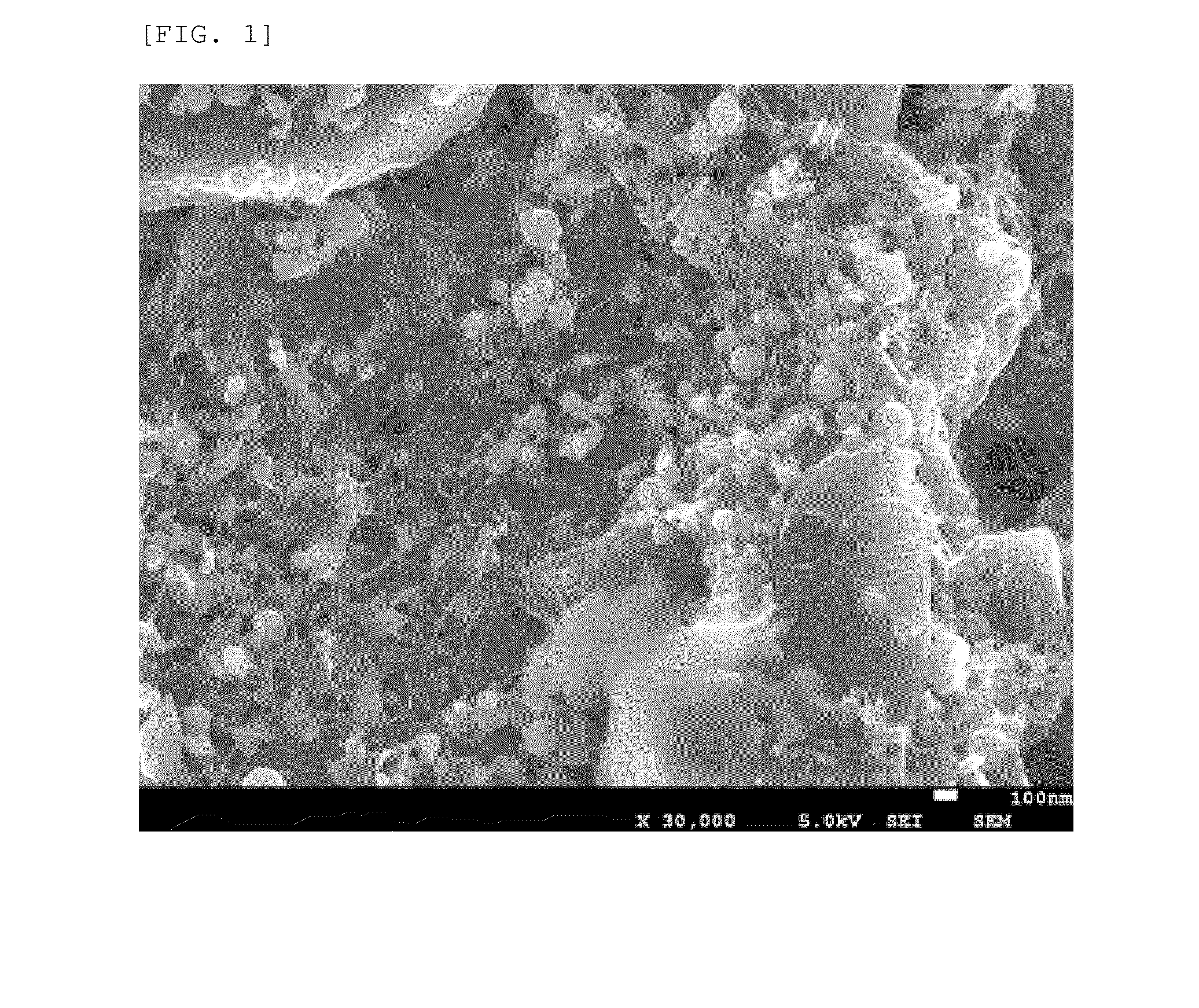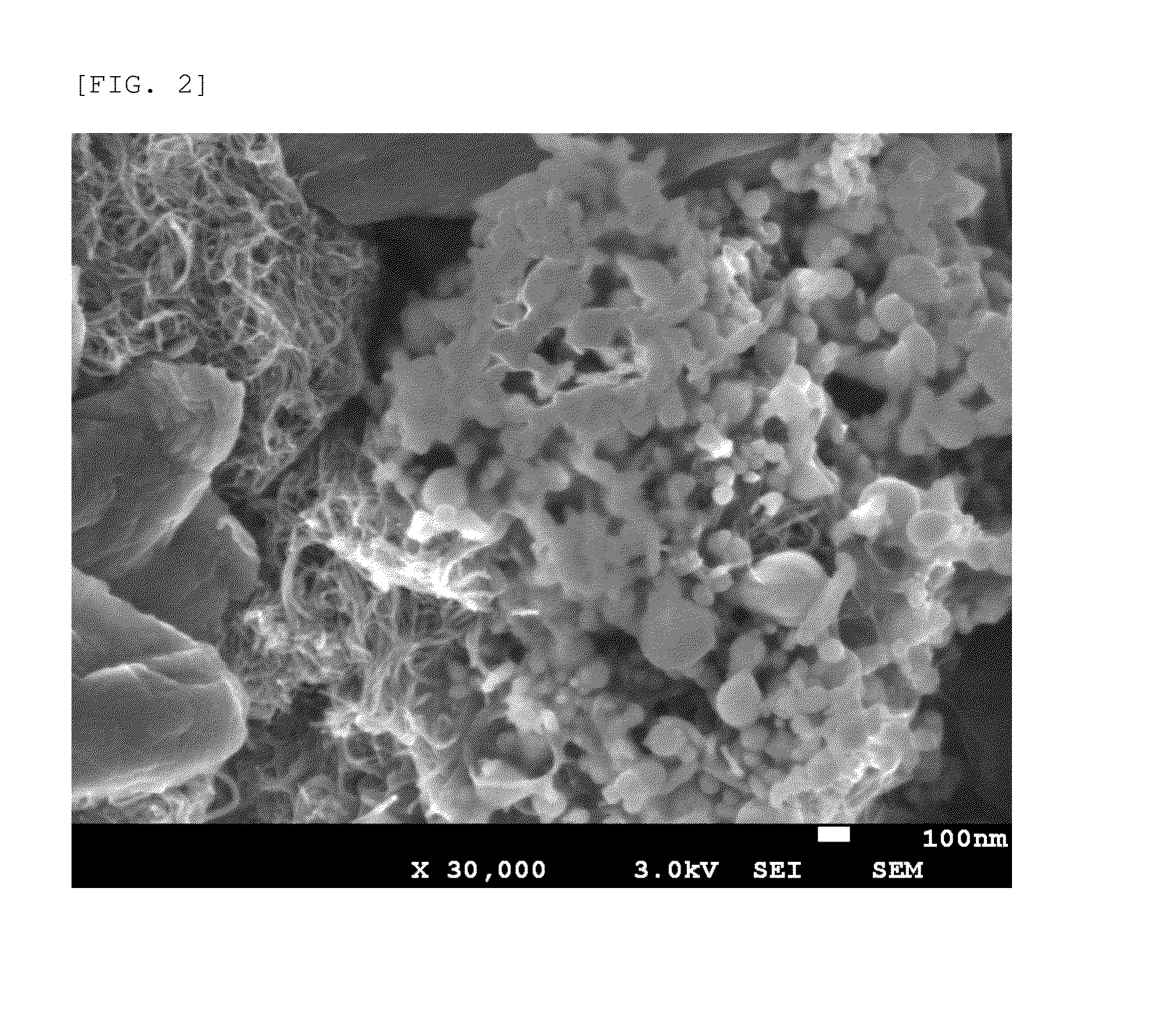Negative electrode material for lithium ion secondary battery
- Summary
- Abstract
- Description
- Claims
- Application Information
AI Technical Summary
Benefits of technology
Problems solved by technology
Method used
Image
Examples
example 1
[0067]With 1960 parts by mass of pure water and a stirring bar fed into a beaker, the beaker was placed on a magnetic stirrer. Into the pure water, 32.1 parts by mass of the particles (B) (Si particles, manufactured by Aldrich, average particle size of primary particles: not more than 100 nm) and 7.9 parts by mass of the carbon nanotubes (C) (vapor grown carbon fibers, manufactured by Showa Denko K. K., average fiber diameter: 12 nm) were fed and stirred for 5 minutes to obtain a mixed liquid. The mixed liquid was fed into a tank of Nanovater manufactured by Yoshida Kikai Co., Ltd. The mixed liquid in the tank was transferred to a slurry pump using a pressure-feed pump and pressed into a straight nozzle (nozzle diameter: 190 μm) under 150 MPa by the slurry pump to perform a high-pressure dispersion process. Thus, a highly viscous slurry was obtained.
[0068]The obtained slurry was filtered under reduced pressure to obtain a cake-like solid material. The cake-like solid material was fe...
example 2
[0070]A flocculated body comprising the particles (B) and the carbon nanotubes (C) was obtained in the same manner as that of Example 1 except that the amount of the particles (B) was changed to 28.1 parts by mass and the amount of the carbon nanotubes (C) was changed to 11.9 parts by mass. Then, a negative electrode sheet was obtained in the same manner as that of Example 1 except that the amount of the carbon particles (A) was changed to 82.9 parts by mass and the amount of the flocculated body comprising the particles (B) and the carbon nanotubes (C) was changed to 13.1 parts by mass. The surface of the negative electrode sheet was photographed under the SEM at a magnification of 30 k times. Not less than 95% (on a number basis) of the particles (B) on the SEM micrograph had a particle size of not less than 10 nm and not more than 400 nm. The carbon nanotubes (C) on the SEM micrograph were in a state of flocculation. A charge capacity, a discharge capacity, and an initial efficie...
example 3
[0074]A flocculated body comprising the particles (B) and the carbon nanotubes (C) was obtained in the same manner as that of Example 1 except that the amount of the particles (B) was changed to 20 parts by mass and the amount of the carbon nanotubes (C) was changed to 20 parts by mass. Then, a negative electrode sheet was obtained in the same manner as that of Example 1 except that the amount of the carbon particles (A) was changed to 78.6 parts by mass and the amount of the flocculated body comprising the particles (B) and the carbon nanotubes (C) was changed to 17.4 parts by mass. The surface of the negative electrode sheet was photographed under the SEM at a magnification of 30 k times. Not less than 95% (on a number basis) of the particles (B) on the SEM micrograph had a particle size of not less than 10 nm and not more than 400 nm. The carbon nanotubes (C) on the SEM micrograph were in a state of flocculation. A charge capacity, a discharge capacity and an initial efficiency t...
PUM
 Login to View More
Login to View More Abstract
Description
Claims
Application Information
 Login to View More
Login to View More - R&D
- Intellectual Property
- Life Sciences
- Materials
- Tech Scout
- Unparalleled Data Quality
- Higher Quality Content
- 60% Fewer Hallucinations
Browse by: Latest US Patents, China's latest patents, Technical Efficacy Thesaurus, Application Domain, Technology Topic, Popular Technical Reports.
© 2025 PatSnap. All rights reserved.Legal|Privacy policy|Modern Slavery Act Transparency Statement|Sitemap|About US| Contact US: help@patsnap.com


